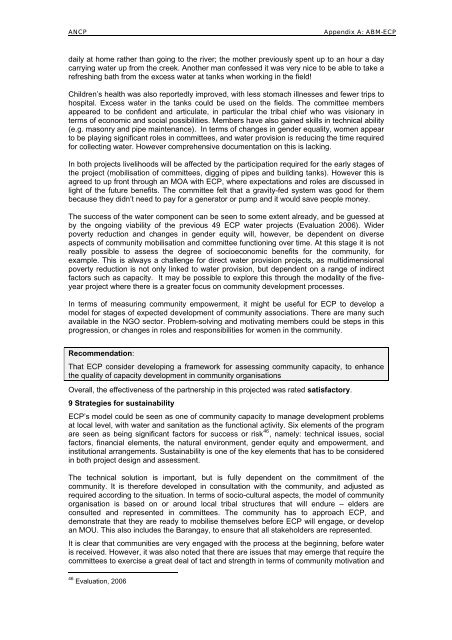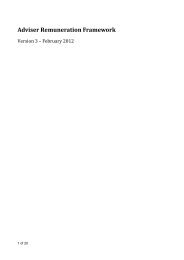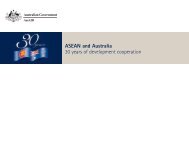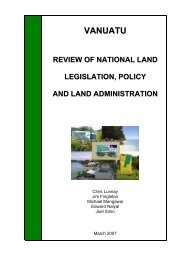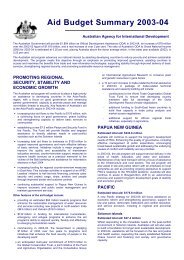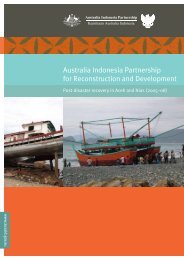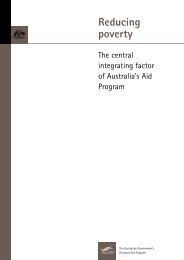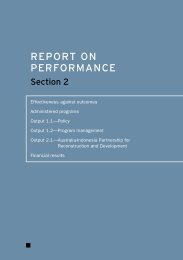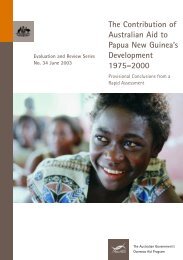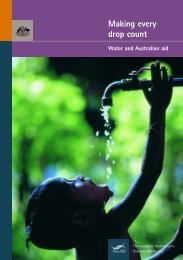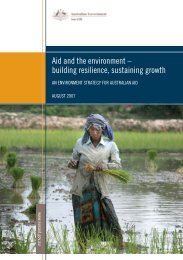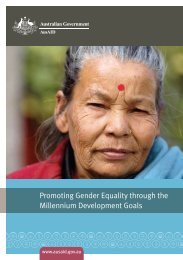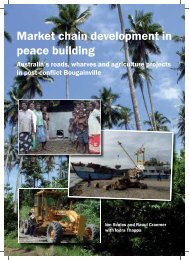ANCP Philippines Cluster Evaluation Report - AusAID
ANCP Philippines Cluster Evaluation Report - AusAID
ANCP Philippines Cluster Evaluation Report - AusAID
Create successful ePaper yourself
Turn your PDF publications into a flip-book with our unique Google optimized e-Paper software.
<strong>ANCP</strong>Appendix A: ABM-ECPdaily at home rather than going to the river; the mother previously spent up to an hour a daycarrying water up from the creek. Another man confessed it was very nice to be able to take arefreshing bath from the excess water at tanks when working in the field!Children’s health was also reportedly improved, with less stomach illnesses and fewer trips tohospital. Excess water in the tanks could be used on the fields. The committee membersappeared to be confident and articulate, in particular the tribal chief who was visionary interms of economic and social possibilities. Members have also gained skills in technical ability(e.g. masonry and pipe maintenance). In terms of changes in gender equality, women appearto be playing significant roles in committees, and water provision is reducing the time requiredfor collecting water. However comprehensive documentation on this is lacking.In both projects livelihoods will be affected by the participation required for the early stages ofthe project (mobilisation of committees, digging of pipes and building tanks). However this isagreed to up front through an MOA with ECP, where expectations and roles are discussed inlight of the future benefits. The committee felt that a gravity-fed system was good for thembecause they didn’t need to pay for a generator or pump and it would save people money.The success of the water component can be seen to some extent already, and be guessed atby the ongoing viability of the previous 49 ECP water projects (<strong>Evaluation</strong> 2006). Widerpoverty reduction and changes in gender equity will, however, be dependent on diverseaspects of community mobilisation and committee functioning over time. At this stage it is notreally possible to assess the degree of socioeconomic benefits for the community, forexample. This is always a challenge for direct water provision projects, as multidimensionalpoverty reduction is not only linked to water provision, but dependent on a range of indirectfactors such as capacity. It may be possible to explore this through the modality of the fiveyearproject where there is a greater focus on community development processes.In terms of measuring community empowerment, it might be useful for ECP to develop amodel for stages of expected development of community associations. There are many suchavailable in the NGO sector. Problem-solving and motivating members could be steps in thisprogression, or changes in roles and responsibilities for women in the community.Recommendation:That ECP consider developing a framework for assessing community capacity, to enhancethe quality of capacity development in community organisationsOverall, the effectiveness of the partnership in this projected was rated satisfactory.9 Strategies for sustainabilityECP’s model could be seen as one of community capacity to manage development problemsat local level, with water and sanitation as the functional activity. Six elements of the programare seen as being significant factors for success or risk 46 , namely: technical issues, socialfactors, financial elements, the natural environment, gender equity and empowerment, andinstitutional arrangements. Sustainability is one of the key elements that has to be consideredin both project design and assessment.The technical solution is important, but is fully dependent on the commitment of thecommunity. It is therefore developed in consultation with the community, and adjusted asrequired according to the situation. In terms of socio-cultural aspects, the model of communityorganisation is based on or around local tribal structures that will endure – elders areconsulted and represented in committees. The community has to approach ECP, anddemonstrate that they are ready to mobilise themselves before ECP will engage, or developan MOU. This also includes the Barangay, to ensure that all stakeholders are represented.It is clear that communities are very engaged with the process at the beginning, before wateris received. However, it was also noted that there are issues that may emerge that require thecommittees to exercise a great deal of tact and strength in terms of community motivation and46 <strong>Evaluation</strong>, 2006<strong>ANCP</strong> <strong>Philippines</strong> <strong>Cluster</strong> <strong>Evaluation</strong> <strong>Report</strong> (ver. 2.0)X


